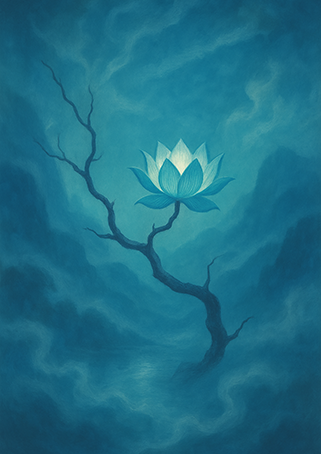Xieyi・The Rootless Tree:100 Verses-Verse 25#555

The poems of “The Rootless Tree” express a fundamental force rooted in harmony with heaven and earth, the cyclical flow of yin and yang, and the infinite potential of existence。
This painting is an expressive “Xieyi” in the tradition of “futu” (spiritual diagrams), passed down for generations in Wudang Mountain, China. It is drawn through a technique where energy flow (xingqi) channels the internal intention into visual form。 In the Taoist world, there exist spiritual and symbolic images called “futu”。
In the Taoist world, there exist spiritual and symbolic images called “futu”。
These are a type of talisman—not merely religious items, but expressive spiritual paintings that act directly on the mind of the viewer。
Since ancient times, many people have placed these Taoist-style “Xieyi” and futu in their homes, studies, or bedrooms, wishing for longevity, health, auspiciousness, and family harmony. Viewing such paintings was not just aesthetic appreciation, but an act of inviting the presence of the Dao into one’s life and tuning the body and mind。
Thus, “Xieyi” is more than artistic expression—it is a medium that bridges the spirit, life, and harmony with the universe。
This kind of artwork is not meant to be seen only with the eyes, but felt with the heart。
It communicates with the Dao, resonates with the qi of nature, and quietly stirs the viewer’s inner self。
Futu and “Xieyi” continue to live on from ancient times to this day as “sacred images that speak to the soul.”
Below, we present the original text of the philosophical poem “The Rootless Tree,” along with a modern Japanese translation and interpretation。
※ The author of “The Rootless Tree,” Zhang Sanfeng (1247–?), is also renowned as the founder of Tai Chi, and it is said that he applied the essence of this work to Tai Chi. As an additional note, we include an interpretation connecting this to the Tai Chi tradition of Wudang Mountain.
The Rootless Tree・Verse 25

▶Original Text
無根樹,花正靜,風過不動水無聲。虛懷若谷藏天地,一氣迴旋合太清。
▶Modern Translation
A silent flower graces a rootless tree;
Wind passes—no sway; water lies without a sound.
Holding a valley-wide emptiness that embraces Heaven and Earth,
One qi turns within, joining the realm of Great Clarity.
▶Interpretation
1.[無根樹,花正靜] The emblem of unshakable calm.
2.[風過不動水無聲] External force leaves no ripple.
3.[虛懷若谷藏天地] “Valley-mind”: humble, vast, containing the cosmos.
4.[一氣迴旋合太清] Circling qi unites with the purest Heaven.
▶Interpretation related to Tai Chi
•Move in stillness; stillness in movement.
•Use quiet to govern motion (yi jing zhi dong).
•Receive force with empty valley chest.
•Complete qi cycle merges self and universe.
Copyright © MASAKI WAKABAYASHI. All rights reserved.




